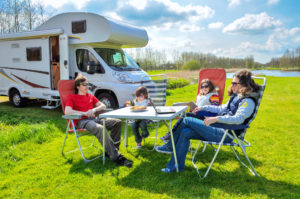 RV sales have skyrocketed since the onset of the COVID-19 pandemic, as families search for ways to vacation while respecting social distancing rules. What better way to quarantine at home than with a home on wheels? But, vacations aren’t the only thing RVs are good for! For years, insurance companies, government agencies, and disaster relief organizations have taken advantage of the many benefits of using RVs as temporary housing.
RV sales have skyrocketed since the onset of the COVID-19 pandemic, as families search for ways to vacation while respecting social distancing rules. What better way to quarantine at home than with a home on wheels? But, vacations aren’t the only thing RVs are good for! For years, insurance companies, government agencies, and disaster relief organizations have taken advantage of the many benefits of using RVs as temporary housing.
Choosing the correct RV for your clients’ unique situations can seem quite overwhelming due to the variety of options available. Newer models offer features you probably never even thought could be on an RV, like hot tubs or full internet connectivity! Regardless of if the client wants a no-frills pop-up camper or a luxury townhouse on wheels, there’s an RV for everyone these days.
Before you start searching the marketplaces for RVs to accommodate your clients during displacement, use this quick guide to learn about the different types of RVs and their capacities:
- Motorhomes
For the ultimate RV experience, consider a motorized RV, also known as a motorhome. These are the RVs you see people driving instead of towing (think celebrity tour bus style). There are three different classes of motorhomes available:
- Class A
Class A Motorhomes are the creme de la creme of RVs. They boast all of the same amenities as a home. A full range of appliances is usually available in a Class A motorhome, along with spacious living and sleeping areas, and even multiple bathrooms!
Class A motorhomes can be even further divided into diesel and gas. Diesel Class A motorhomes are the most powerful and longest lasting, but also the most expensive. On the other hand, gas Class A motorhomes are more affordable. However, both gas and diesel Class A motorhomes are 30-40 feet long, similar to a bus.
Class A motorhomes are the best option for very large families or groups that wish to stay together during trips. Extra long stays will also be more comfortable in a Class A, but navigation can be an issue due to its large size.
- Class B
Class B motorhomes are also called camper vans, and that’s exactly what they look like. Built on a van chassis, these agile campers are small enough to fit almost anywhere. Great for couples and solo travelers, Class B motorhomes measure from 20 to 25 feet in length and are super organized so that everything you need fits.
- Class C
The Class C motorhome is the most common of the motorized RVs. Built on a truck chassis, this mid-sized motorhome still includes many of the comforts of home, just on a smaller scale. Because of their smaller size, Class C motorhomes can fit in places where Class A motorhomes can’t go, which makes Class C motorhomes great for small to medium families and groups.
- Fifth Wheels
Fifth wheels are a type of RV that is pulled along behind a pickup truck that is equipped with a special hitch. These are the largest towable campers, and perfect for families that need to move their RV, but still wish to use their vehicle separately once the RV is in place.
Fifth wheels offer the addition of slide-outs for expansion and even maximize that space over the hitch with additional living space. However, there is a learning curve when it comes to setting up a fifth wheel since everything must be balanced and leveled perfectly.
- Travel Trailers
Travel trailers are probably the most popular RVs, being both affordable and versatile. Towed by a hitch attached to its frame, travel trailers can be pulled and parked almost anywhere. They vary in length and offer many configurations to fit any need.
Travel trailers are great for couples, groups, and small to medium-sized families. They are easy to move around and set up.
- Tiny Trailers
A current camping trend involves tiny trailers, also known as teardrops. These miniature travel trailers maximize every square inch to include everything a traveler might need. Great for a solo traveler or couple for a very short stay, tiny trailers have gained a cult following in recent years.
- Pop-up Campers
Pop-up campers are ultra-lightweight, can be towed by almost any vehicle, set up in minutes, and accommodate several people. For overnight stays, a pop-up camper is your easiest and most convenient option but doesn’t offer much protection from wind or rain, and storage is pretty much non-existent.
- Toy Haulers
Toy haulers are a subcategory of RV and can actually be any of the previous RV types listed! However, most toy haulers are fifth wheels. Originally designed for the specific purpose of hauling outdoor toys and other motorized equipment, such as 4-wheelers, motorcycles, and dirt bikes, modern toy haulers offer much more than just garage space. Users will find toy haulers to be just the right balance of living space and storage.
When you have a client depending on you for their shelter, you want to be sure you’re offering options that are comfortable, safe, and affordable. Armed with the knowledge of different RV types, you can now make a better decision about which RV type is best for you and your client’s situation. When you’re ready to rent RVs to house your displaced clients, contact RV Housing Group at 1-800-656-8706 or online to request a quote and find out how RV rental can satisfy all your client housing needs.

